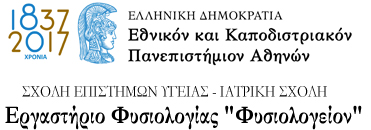Associate Professor
- HOME
- FOR VISITORS
- RESEARCH – INFRASTRUCTURE – SERVICES
- Research Laboratories
- George Kollias, Professor
- Theodoros Vasilakopoulos, Professor
- Mavragani Kleio, Professor
- Panagoula Aggelogianni, Assoc. Professor
- Christos Konsoulas, Assoc. Professor
- Athanasios Armakolas, Assoc. Professor
- Philippou Anastassios, Professor
- Mara Simopoulou, Professor of Physiology-Clinical Embryology
- Antonios Chatzigeorgiou, Assoc. Professor
- Konstantinos Palikaras, Assist. Professor
- Infrastructures
- Services
- Research Laboratories
- MEMBERS
- UNDERGRADUATE STUDY
- MASTER’S PROGRAMMES
- CONTACT

- HOME
- FOR VISITORS
- RESEARCH – INFRASTRUCTURE – SERVICES
- Research Laboratories
- George Kollias, Professor
- Theodoros Vasilakopoulos, Professor
- Mavragani Kleio, Professor
- Panagoula Aggelogianni, Assoc. Professor
- Christos Konsoulas, Assoc. Professor
- Athanasios Armakolas, Assoc. Professor
- Philippou Anastassios, Professor
- Mara Simopoulou, Professor of Physiology-Clinical Embryology
- Antonios Chatzigeorgiou, Assoc. Professor
- Konstantinos Palikaras, Assist. Professor
- Infrastructures
- Services
- Research Laboratories
- MEMBERS
- UNDERGRADUATE STUDY
- MASTER’S PROGRAMMES
- CONTACT

“Neurophysiology”
Aim
At the end of this course, which is delivered by both lectures and practicals, students will be able to describe the anatomy and the functional mechanisms of the human nervous system.
General teaching goals
This course aims to provide knowledge about the anatomy, cellular physiology, and normal function of the human nervous system.
Course content
General:
This course falls under the subjects of nervous system anatomy and physiology/
This course also includes laboratory-based teaching on the function and regulatory mechanisms of the nervous system.
Content Overview:
Neuroanatomy
INTRODUCTION. CEREBRAL HEMISPHERES. SPINAL CORD. NUCLEI – BASAL GANGLIA. BRAIN STEM. CEREBELLUM. CRANIAL NERVES III,IV,V,VI. CRANIAL NERVES VII,IX,X,XI. BRAIN VASCULARISATION – VENTRICULAR SYSTEM – MENINGES. SENSORY SYSTEMS (ORGAN: VISION – CN ΙΙ, ORGAN: SMELL – CN Ι, ORGAN: HEARING – BALANCE – CN VIII). AUTONOMIC NERVOUS SYSTEM – BASIC FUNCTION ANATOMY
Neurophysiology
Introduction to nerve cells. Membrane potential. Energy potentials. Synaptic transmission. Reflexes. Autonomic nervous system. Somatosensory system. Vision. Hearing and vestibular system. Chemical senses: Smell and taste. Voluntary movement control ECG: neurophysiological basis. Sleep/wake cycle. Learning and memory. Language and speech. Physiology of cerebrospinal fluid and cerebral blood flow. Blood-brain barrier.
Αρχεία/downloads
© Copyright 2008-2023 Εθνικό και Καποδιστριακό Πανεπιστήμιο Αθηνών • powered by Nevma

